Best Deadlift Back Angle For Your Size & Build (With Pictures) | PowerliftingTechnique.com (original) (raw)
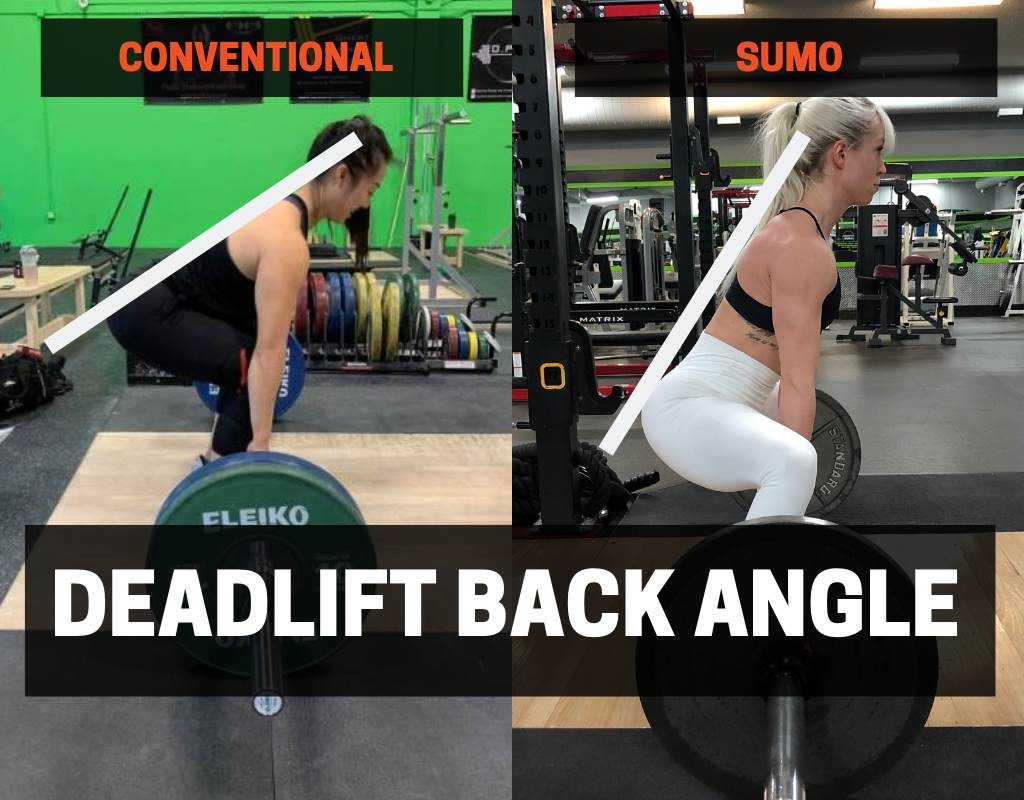
Having the proper back angle for deadlifts, especially in your start position, is one of the most critical steps in executing the deadlift effectively. The back angle is defined as your torso position in relation to the floor.
So, what should your deadlift back angle be? The angle of your back is going to depend on your size and build. If you have long legs combined with a short torso, or short arms generally, then your back angle is going to be more horizontal to the floor in your set-up. Alternatively, if you have short legs combined with a long torso, or long arms generally, then your back angle is going to be more vertical. The angle of your back will also depend on whether you deadlift conventional or sumo. In a conventional deadlift, you will have slightly more forward lean when compared with a more vertical back position in the sumo deadlift.
In this article, I'll break down exactly what back angle you should have based on your size and build. We'll also discuss the differences in the back angle based on conventional and sumo deadlift.
At the end of the day, it's important to remember that the best back angle for deadlifts is the one that allows you to lift the most amount of weight.
You may also wonder whether it's okay if your back rounds in the deadlift (some powerlifters say yes).
Table of Contents
Toggle
- 3 Deadlift Technique Principles You Need To Consider Before Worrying About Your Back Angle
- How Your Leverages Affect Back Angle While Deadlifting
- Back Angle For Conventional & Sumo Deadlifts
- Common Mistakes with Back Angle for Deadlifts
- Final Thoughts
- Resources
3 Deadlift Technique Principles You Need To Consider Before Worrying About Your Back Angle
The angle of your back during deadlifts is going to depend on how you're built.
But, no matter how you're built there are three common technique principles that you're going to want to focus on.
We need to cover these technique principles first because they will lay the groundwork for how you set up the most effective back angle for your size and build.
1. Bar over midline of foot
Before you bend over to grab the bar, you'll want to ensure that the bar is directly over the midline of the foot.
There should naturally be a few inches between your shins and the barbell in this position.
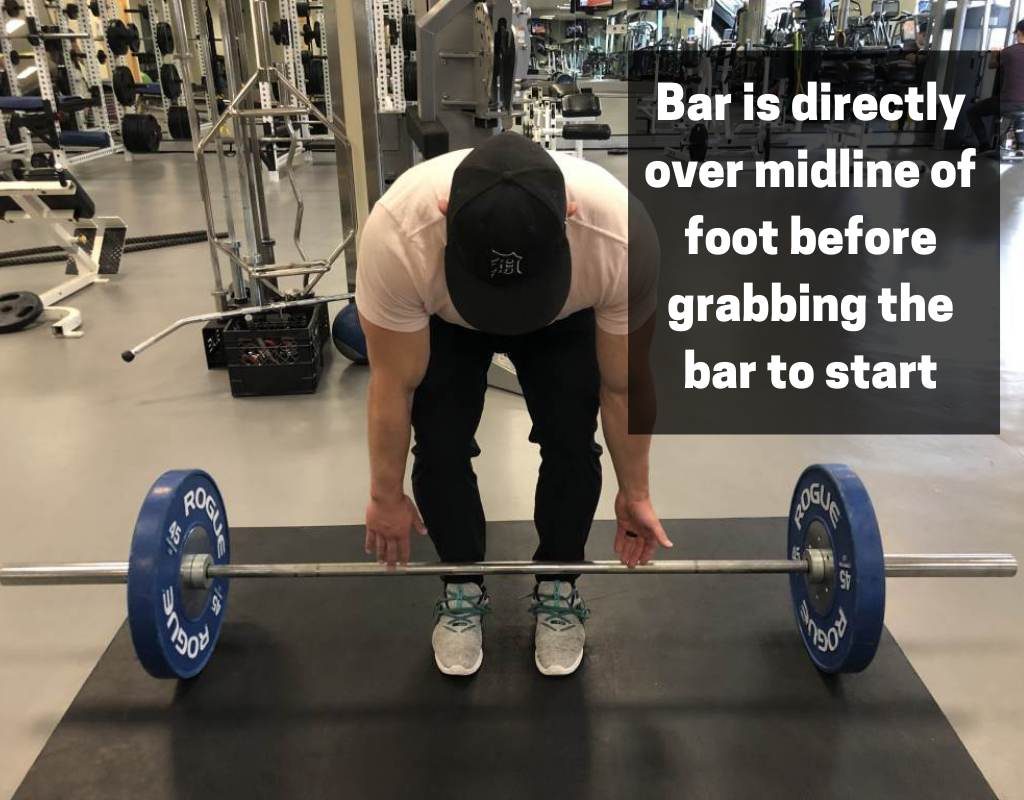
Having the bar over the midline of the foot will allow you to pull the bar vertically off the floor. This is beneficial because:
- It will limit the range of motion ultimately traveled. A straight line is the shortest distance between two points (start and finish).
- It will keep you balanced over your center of gravity, and be the most effective position to transfer force into the floor.
2. Shins touch the bar
When you're ready to grab the barbell, your hips will lower toward the floor and simultaneously your shins should move to touch the barbell.
Make sure to avoid pushing the barbell forward with your shins. If you do this, you'll lose out on the first technique principle of maintaining the barbell over the midline of the foot.
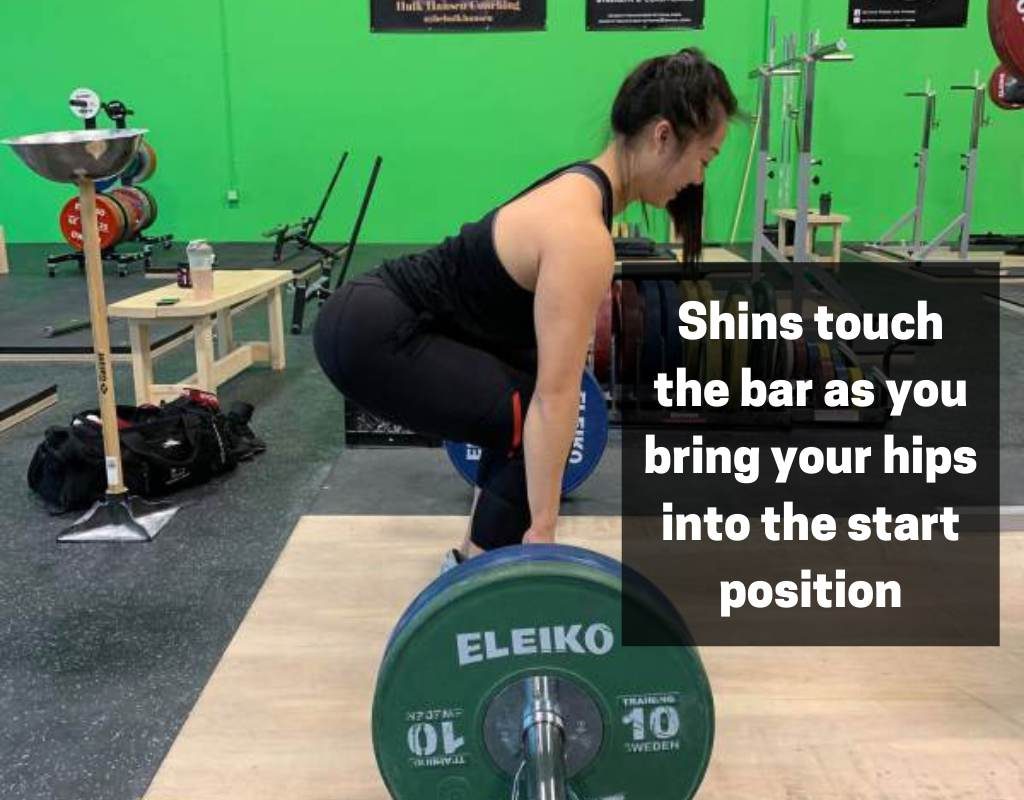
Having your shins touch the bar in the start position is beneficial because:
- It will allow you to keep your lats tighter by not having the bar drift in front of you. When the bar drifts forward your lats need to work a lot harder, and you might end up rounding your upper back.
- It will prevent you from losing your balance forward, and potentially dropping the bar or taking a step.
If your shins aren't touching the bar in the start position, you will create a deadlift weakness off the floor.
3. Shoulder position either slightly in front or directly in line with the barbell
The first two technique principles will apply equally whether you're deadlifting conventional or sumo.
However, your shoulder position is going to vary slightly based on which style you choose to deadlift.
In a conventional deadlift, you want your shoulder position to be slightly in front of the barbell.
In a sumo deadlift, you want your shoulder position to be directly over the barbell.
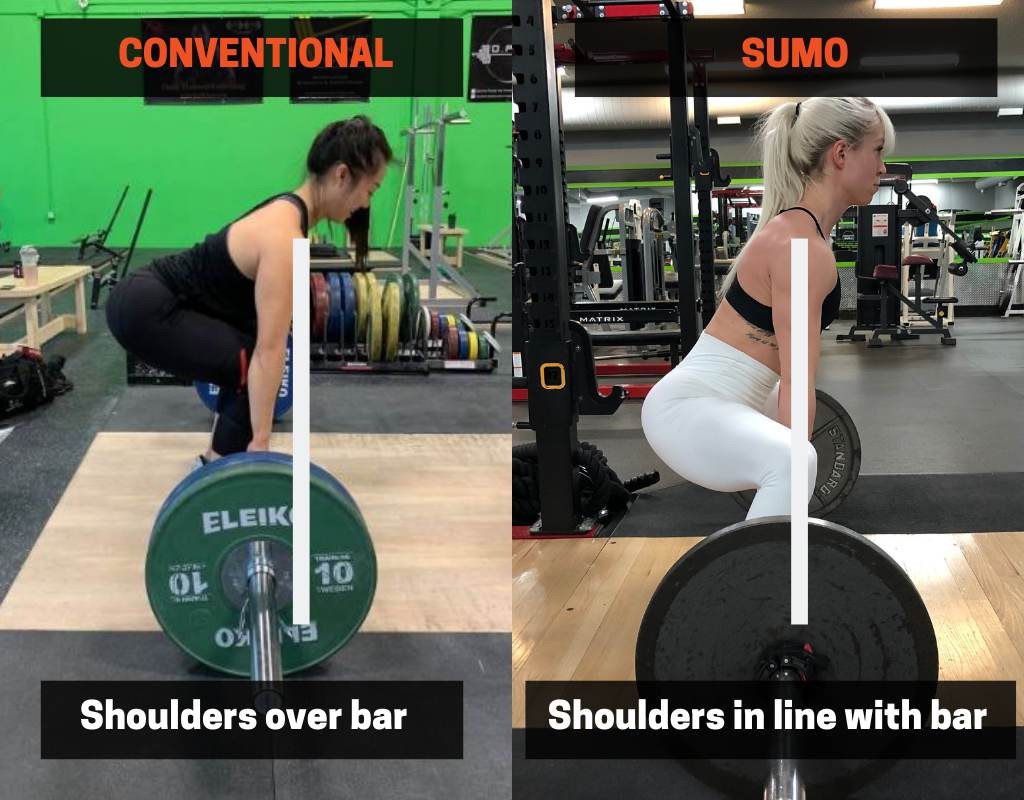
Having your shoulder position set correctly in the start position is beneficial because:
- It will ensure your hip position is not ‘too low'. The further back your shoulders are behind the bar, the lower your hips need to drop. This will increase the range of motion of the overall movement.
- It will ensure you can pull the barbell straight up rather than ‘up and around your knees'. Remember any bar path that isn't vertical will be wasted effort. Read my article on the best bar path for deadlifts.
If you want to learn how to keep your back straight while deadlifting you can read our latest article discussing how to create back stiffness, and exercises to help build stronger back muscles while deadlifting.
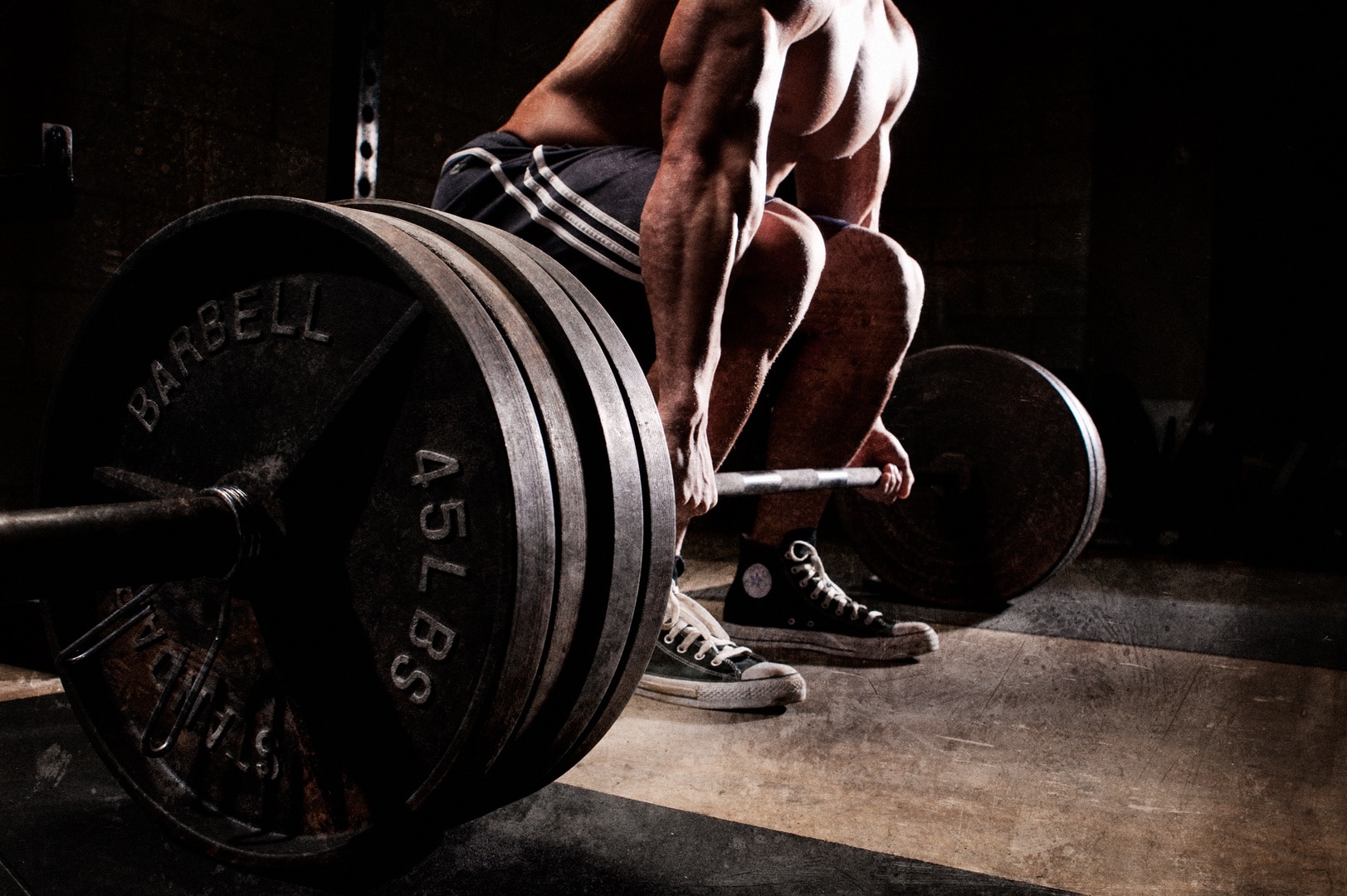
Want to improve your deadlift technique?
How Your Leverages Affect Back Angle While Deadlifting
If you've mastered the three technique principles above, then your back angle should naturally fall into the right position.
You definitely don't want to compare your back angle with other people though because the exact angle will depend on your individual leverages.
Your leverages refer to how long or short certain limb lengths are in relation to one another. In the deadlift, we're specifically looking at the length of your torso, upper/lower leg, and arms.
Based on the length of your limbs, your back angle will be more or less horizontal to the floor.
Related Article: Deadlifting With Anterior Pelvic Tilt: Risks & How To Fix
Your back angle will be more horizontal to the floor if you have short arms generally, or you have a combination of long legs and a short torso. Check out my article on deadlifting for tall guys for a deep dive into how to deadlift with long legs.
Your back angle will be less horizontal to the floor (more vertical) if you have long arms generally, or you have a combination of short legs and a long torso.
A study by Hales (2010) examined the torso, leg, and arm segment lengths as proportions of the overall body structure. These segment lengths offer a reference point to determine whether some limbs are considered ‘long' or short'.
If you're interested in this article, you may also be interested in reading What Is The Best Back Angle For Squats?
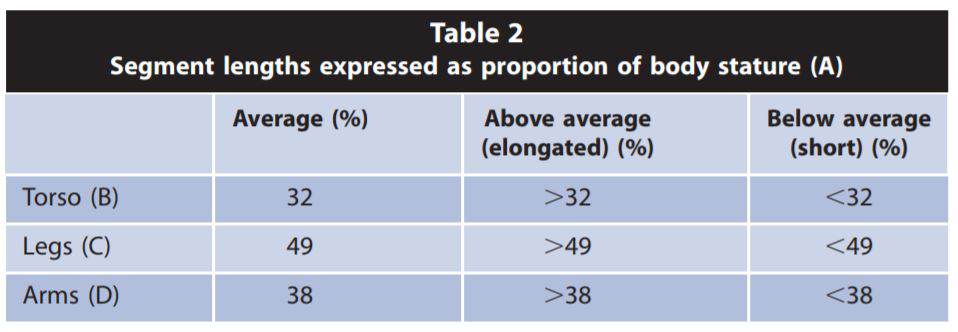
When you’re measuring your proportions, here is how you should measure:
- Torso length: Start at the hip bone (greater trochanter) and measure to the top of the head
- Arm length: Start at the shoulder joint (humeral head) to the tip of the middle finger.
- Leg length: Start at the hip bone (greater trochanter) and measure to the floor.
What this analysis should tell you is whether your back angle will be more or less horizontal to the floor.
It will not tell you an exact back angle. This is because it's extremely hard to prescribe an exact back angle since there are so many other factors involved, including stance width, grip width, level of mobility, muscular strengths/weaknesses, and overall personal preference.
So rather than obsessing about obtaining an exact back angle, just use the limb proportions above as a general measure of whether you should be more or less horizontal to the floor and then play around with what feels the strongest. I will say, that if you have short arms while deadlifting, your back angle will likely be more horizontal to the floor.
For reference, here are my limb proportions:
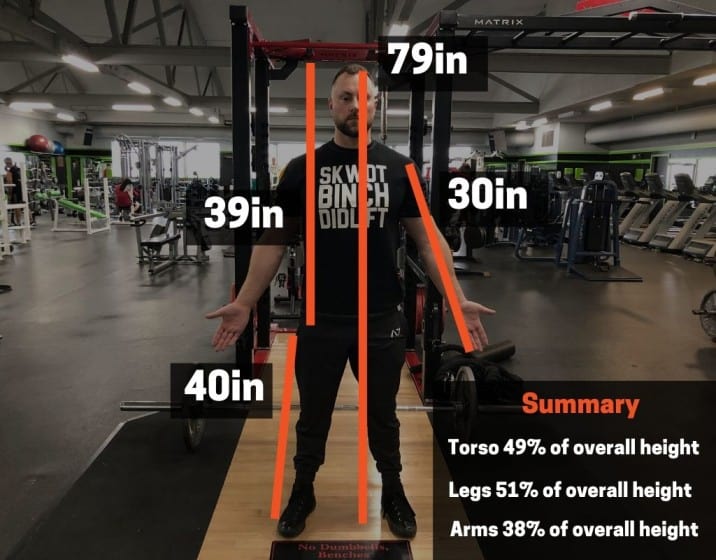
Based on these measurements, I would be classified as someone who has average arms, long legs, and a long torso.
My legs and torso suggest that my back angle would be more upright in its start position. However, I also have average arms, which usually means that my back angle needs to be more horizontal to the floor.
This is contradictory and you can see why there's no exact formula.
But practically speaking, what this means is that my back angle should likely be a bit more vertical based on my torso and leg lengths. However, compared with someone who has longer arms, I'm probably not going to look as upright as they would in their start position because I have average arms.
Note: if your leverages are indicating that you could deadlift either conventional or sumo, you might want to try the semi-sumo deadlift stance.
Related: 18 Exercises To Improve Deadlift Technique
Back Angle For Conventional & Sumo Deadlifts
As I stated above, the shoulder position in relation to the barbell is a critical part of the set up in the deadlift.
Since the shoulder position for conventional and sumo deadlift is slightly different, this is going to change what makes an effective back angle.
In the conventional deadlift you'll have a shoulder position that's just slightly in front of the barbell if you draw a straight line down to the floor. As a result, your back position will be more horizontal toward the floor.
In the sumo deadlift, you'll have a shoulder position that's directly in line with the barbell if you draw a straight line down to the floor. As a result, your back position will be more vertical.
Your back position can be affected by your stance width. Check out my complete guide on how wide should you sumo deadlift.
Of course, there are exceptions on both sides, and you should think about the shoulder position as more of a ‘range' that can be optimal rather than an exact angle.
The limb measurements discussed above will still apply. So whether you deadlift conventional or sumo, you'll want to adjust your shoulder position and back angle based on your proportions.
If you're interested in knowing whether you should deadlift conventional or sumo, and which one will likely be stronger for you, then check out my full guide.
Common Mistakes with Back Angle for Deadlifts
As I said above, there is an optimal range for your back angle to be in while deadlifting. This is based on your proportions and how strong you feel in a specific position.
However, there are definitely mistakes that people make when deadlifting with a back angle that's either too horizontal or too vertical. These mistakes can happen on both conventional or sumo deadlifts.
Mistake #1: The Back Angle Is Too Horizontal
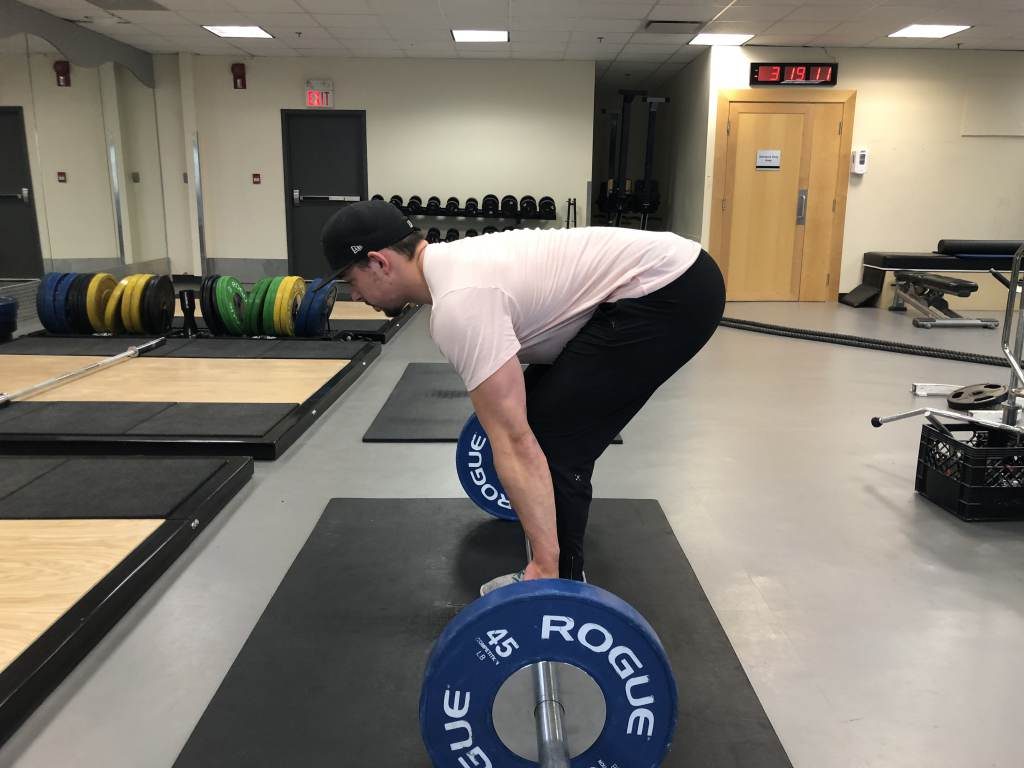
If your back angle starts to become parallel to the floor, then the movement turns into a stiff leg deadlift. As a result, you'll be placing a lot of loading demand on your hamstrings and low/mid back to lift the weight off the floor.
While this might not be a bad thing immediately, especially if you have strong musculature in those areas, you'll find that you reach a plateau in strength much quicker. This is because you aren't using your legs to drive the barbell off the floor.
If you start with your back too parallel to the floor, you can create a deadlift weakness at the knees.
If you find that your hips shoot up in this position off the floor then read my other guide to fix this problem.
Mistake #2: The Back Angle Is Too Vertical
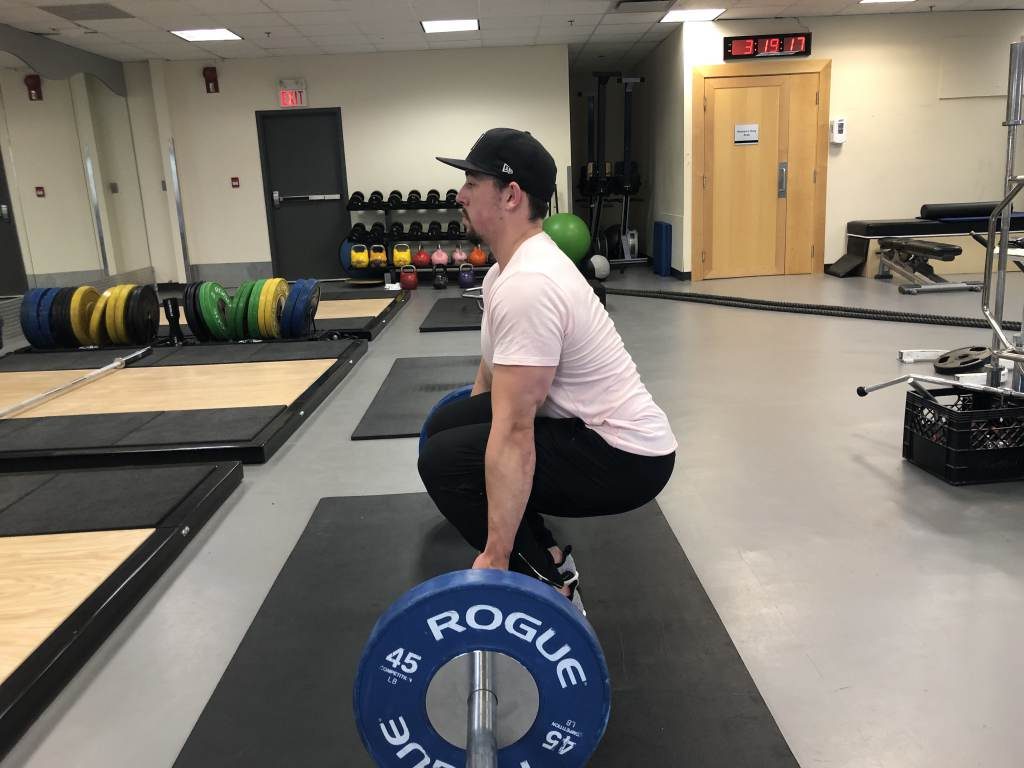
If your back angle is too vertical and your shoulders are behind the bar when you draw a straight line down to the floor, then this means you're ‘squatting' the weight off the floor.
This will cause a few issues:
- It will increase the overall range of motion because your hips are too low.
- It creates an ineffective bar path because now the barbell needs to travel forward to go around the knees.
- You're placing a lot of load demand on your quads without using the musculature of your glutes and low/mid-back.
Again, you can still get strong in this position, but you'll likely hit a plateau much quicker than you would if you tried to optimize your back angle.
If you want to learn more deadlift cues, make sure to check out our article on the TOP 10 DEADLIFT CUES FOR STRONGER PULLS.
Final Thoughts
Before worrying about your back angle you want to ensure that the barbell is over the midline of the foot, that your shins are touching the barbell, and that you have the proper shoulder position for either conventional or sumo deadlift. After those basic technique principles are considered, then the best back angle for deadlift is going to be one in which fits your proportions, as well as allows you to feel the strongest.
Resources
Hales M (2010) Improving the Deadlift: Understanding Biomechanical Constraints and Physiological Adaptations to Resistance Exercise. Strength and Conditioning Journal32(4):44–51.